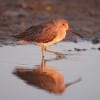 By Jim Stevenson,
By Jim Stevenson,
We will have the typical Sunday morning field trip, $25, on the Island from 8-noon, meeting at the Texas First Bank on FM 3005 in Pirate’s Beach. This cold weather has brought down cranes, ducks and lots more wintering birds! Lunch afterwards for whomever wishes. Feather Fest registration will open again in very early December. Sorry to have steered you that way when it wasn’t ready for you. You still can register on this page now:
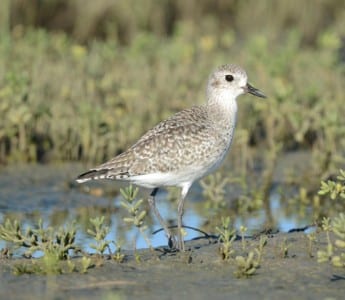
The big, rounded head and relatively short bill helps make this a plover, although most of ours are smaller and have at least a hint of a ring on the chest. This is the very abundant Black-bellied Plover, absent the black belly that develops mid-to late spring. These are not only on the Bay and Gulf sides of the Island; they also wander well away from the shoreline, typical of many plovers.
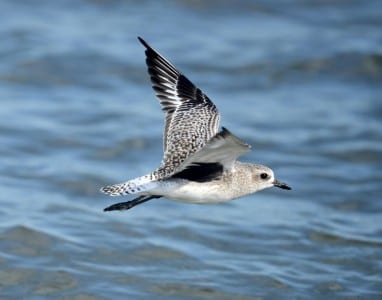
While the bird you just saw has no winter black belly, it does have black, just axillaries. If you have any doubt about the ID, just flush it and you can make sure it’s not a golden plover (of several rare species). These BBPLs also have a lighter crown and larger bill, two field marks that could save you having to flush a resting bird. All the Pluvialis plovers are rather large, much more so that the four “ringed” species.
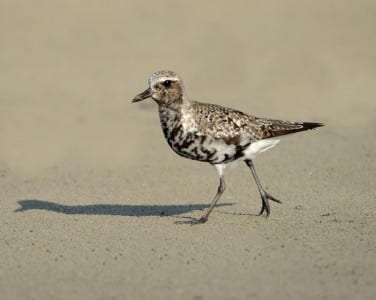
Obviously, this is a changing Black-bellied Plover, and the curious thing is, they don’t all look the same on any given day in early fall. But remember, not all people go through puberty at the same time, either. They obviously aren’t like Dunlins, and stay up North until they finish molting. Sort of a cool picture, huh?
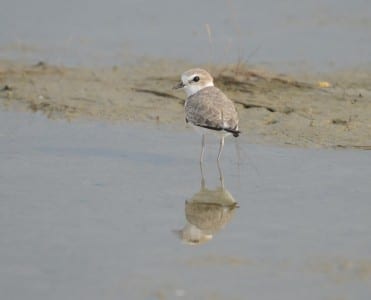
The other plovers on our beaches are in the genus Chardrius and are quite cryptically colored to match the sand or mud. This is the Wilson’s Plover, a species that summers on southern beaches and breeds there (of course). They have flesh-colored legs but this bird almost looks gray there. These are seen late spring and summer on the Bay side, running between grass clumps and hiding on the white substrate. They are a listed species, with coastal development threatening their grounds.
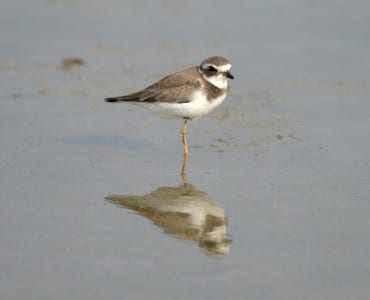
The widespread Semi-palmated Plover is sometimes the least common of the four Charadrius on the beach – especially on the Gulf side. They have relatively dark backs like Wilson’s, which are both adapted more for mud flats (dark) than sandy beaches. Their legs are roughly the same color as the Piping to come, but the dark back and full ring separates them (in the cool season).
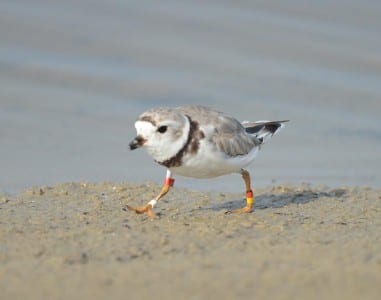
This Piping Plover is full ring this fall and may be ID’ed by its light back and yellow-orange legs. Note the bands: Scientists are working with this species due to its low population, and we get quite a few that both pass through Galveston on their way south, as well as some which winter here. BTW, the bill is also losing its color, becoming all-black.
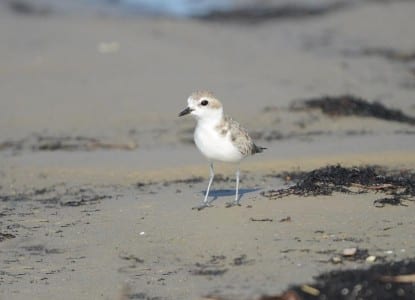
The small plover which really has gray legs (and a light back) is the Snowy Plover. It is a curious thing that they are lighter on the back east of the Mississippi River, due to the whiteness of the beaches back toward Florida. Sediments emerging from the big river wash west, caused by longshore currents, and make our two States have grayer beaches. I can only imagine what the tourism people think of the sediments, not to mention the horrible sargassum.
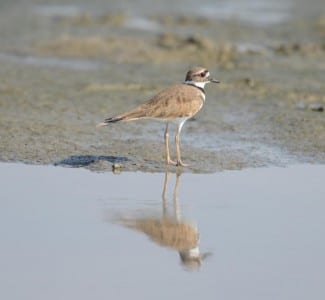
The off-beat Charadrius is the Killdeer, a slender bird that is more often seen away from water, perhaps on somebody’s lawn. They become very abiding of people and practice the rouse of feigning, when they appear crippled, to draw predators away from their eggs or young. They have two rings, of course, in all seasons.
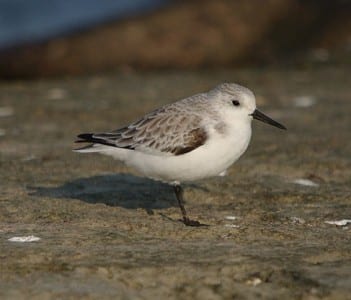
The chubby little Sanderling is often mistaken by beginners for a plover, as it is about the same side as the Charadrius, and has a relatively short bill (well, for a sandpiper). This is by far our most abundant beach bird, hanging out with Black-bellied Plovers and Western Willets (fall and winter). Curiously, Eastern Willets don’t spend as much time on the beach (Gulf) side, as they nest on the Bay side and chase stuff like fiddler crabs. Notice the black on the wing-bend, a frequent ID aid with this species.
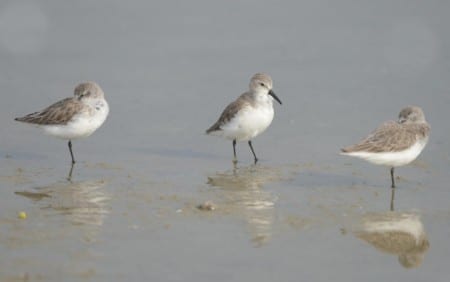
Size in sandpipers varies greatly, so we’ll start at the bottom, with peeps. These are Western Sandpipers, our Continent’s most abundant species. Notice they have a longish bill for their diminutive size, and it even droops a bit on the terminus. Oftentimes when you see shorebirds sleeping during the day, the answer lies in three possible reasons: 1) They were foraging by night when there was a low tide; 2) They just completed their long, arduous migration to our shores; or, 3) The middle one is telling a really lame joke. Perhaps also why they are on one leg!;) Least Sandpipers are a tad smaller than Westerns, being our smallest shorebirds on Earth. They tend to be a bit browner, especially in spring, but the big thing is the yellow legs. They also wander and forage away from water frequently, where their more brownish color allows them to camouflage better. These musketeers are sheltering themselves from the northeast gale while their more exposed Western friends just have to suck it up.
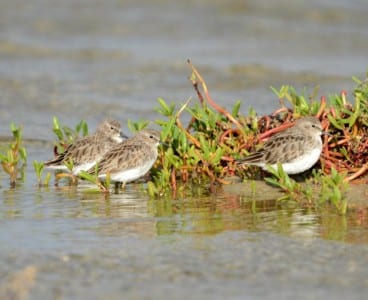
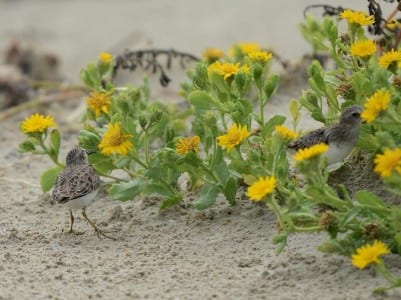
By virtue of feeding away from the shoreline frequently, Leasts have a few tricks up their sleeves. Here they are feeding on tiny arthropods hidden in the yellow flowers (species?). Of course, in fall, just about ALL flowers down here are yellow! Again, the leg color… Maybe I’m actually a closet mammalogist (not!), but Leasts have always reminded me of feathered mice.
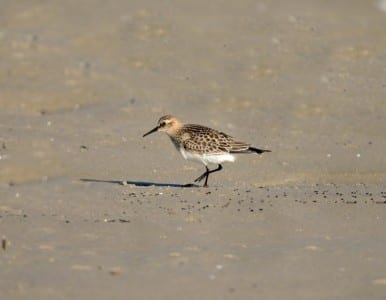
A peep that passes through our area in early fall is the Baird’s Sandpiper, departed to South America weeks ago. The long, thin, straight bill and black legs help distinguish it from a Least, the brownish back separates it from Western, and the scaly back pattern separate it from all other peeps (and catfish). They also wander away from water like Leasts do, possibly the reason they have a browner back. Note the long wings, like a White-rumped (which ain’t never here in fall). I know one English major out there that just screamed.
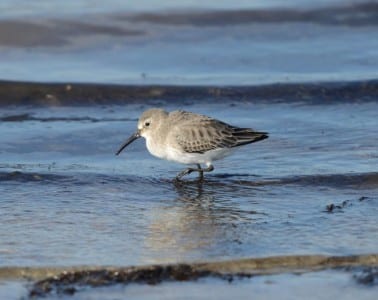
Dunlins don’t really arrive until well into October, because 1) They visit Hawaii on the way; 2) They molt before arriving; 3) The females have to stop and ask directions; and, 4) The males should, but don’t. OK, it’s #2. So we don’t see the reddish backs or black bellies in fall; they are in perfect winter plumage upon arrival. I have seem many a birder call this beast a Western Sandpiper, and Westerns even have a bit of a droopy bill (but not like the Dunlin). They also feed a little deeper than Westerns, and are very slightly larger than Sanderlings. What? You wanna see more Dunlinage?
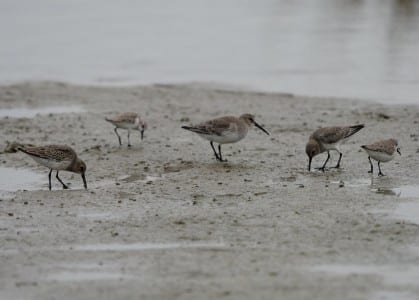
Here are some of different looks, because of molt-stage, but the three large ones are just winter-plumaged Dunlins. And yes, the other two are Westerns. They carry themselves similarly, too, but not all peeps feed with that same posture (thank you, KK). These birds are likely picking up polycheate worm larvae, one of the most abundant groups of animals on the entire Planet.
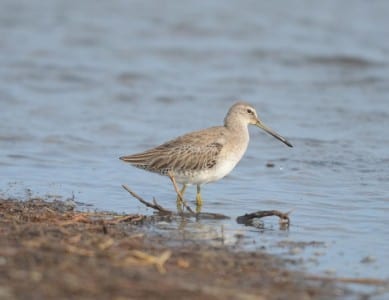
Larger than Dunlins are the dowitchers, plump sandpiperswith snipe-like long bills. Do you know which species? Come on you experts, take a look and stop peaking! …… OK, the best way from this bird is the faint streaking on the face, as the other species is plain there. OK, it’s a Short-billed Dowitcher, and think of “S” for “short” as well as “streaked (face).” BTW, ecology also pretty well separates the dowitchers in winter, as the SBs prefer salt water and the LBs, fresh. Think: Short, salt; Long, lake. Get it? But maybe the best field mark is the call, as SBs say “tu tu…” and LBs (seen here in the migration) say, “Eek!” Especially when you throw a rock their way to get them to call.
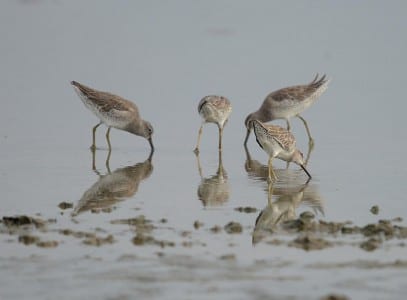
Worms and other inverts are not always the same depth. Here, these SBs are feeding very shallow, probably not on polycheates. I especially like how shorebirds get along so peacefully, not like a lot of land birds I know. Of course, there is a bonanza of inverts in those shallow flats, enough for everybody. Word of caution: Beware of those kind of ¬yellow legs, that you don’t oops-up and call one a Lesser or Greater YLs.
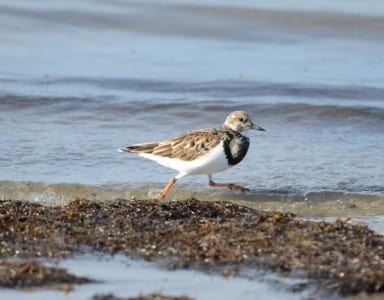
Easy for most is the winter Ruddy Turnstone, ecologically a plover, but really, a sandpiper with a short bill. That stout, chisel bill pries into mollusks, and they also use it to flip over shells and such for small marine life. This one is in the drab winter garb but you have to like the orange legs. You guys out West also have Black Turnstones, due to the volcanic rock. Now, your reward for suffering through these boring plover and sandpiper shots is some I took in low-light conditions, just before the sun was setting. I’m almost pleased, though that comes hard for me…
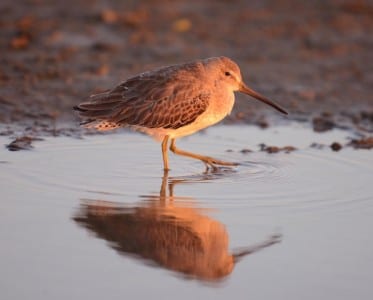
The aforementioned Short-billed Dowitcher, with the reddish cast of sundown. Enjoy. His giant friend, the Marbled Godwit, with a worm pulled up from the briny depths.
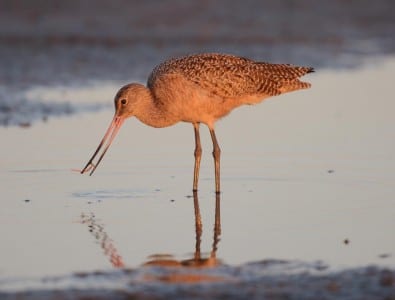
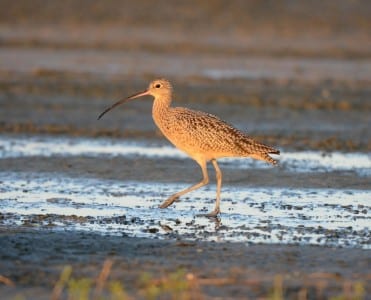
A Long-billed Curlew male, with glowing reports. And then she flushed… And buddy, I can’t do any better than this last one…
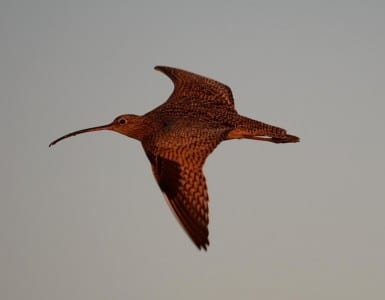
As the light faded in the West, he disappeared. Where he went will eventually dawn on me. 😉

 Posted in
Posted in 























